After finishing first in their group with seven points and without conceding any goals but only scoring two, England had to face Germany in the round of 16. The Germans finished second in the ‘Group of Death’ with four points and despite having a great attack and scoring six goals, their defence looked shaky with five goals conceded.
In front of 42,000 people at Wembley, one of the European greatest classic matches was played once again. With the Germans unbeaten in their last five visits to Wembley and their last encounter in a knock-out phase being Germany’s 4-1 victory in the 2010 World Cup, recent history was against England.
In a very tight match, England managed to defeat Germany 2-0 to progress into the quarter-finals. In this tactical analysis, we’ll look at both teams tactics to understand the key aspects that led to the final result.
Lineups
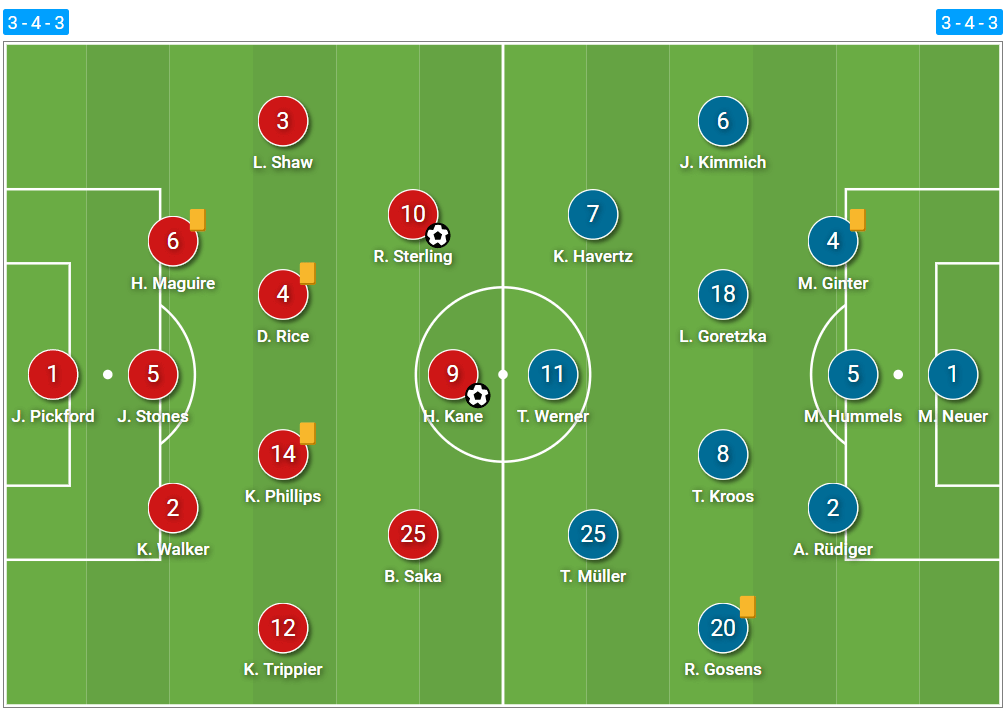
For the first time in the tournament, Southgate changed to the 3-4-3 formation that gave England great results in the last World Cup, changing Grealish for a wing-back. Pickford, still unbeaten, started in goal with Walker, Stones and Maguire as the centre-back trio. On the wing-backs, Trippier got into the team for the first time since the first matchday and Shaw continued on the left. RIce and Phillips, a very solid partnership, completed the midfield line. Upfront, Sterling and Saka played alongside captain Kan. England’s bench was full of attacking options with Grealish, Foden, Mount, Rashford and Sancho.
On the away side, Löw also opted for the 3-4-3 formation and made three changes from their draw against Hungary. Goretzka played instead of Gündogan, forming a partnership with Kroos in midfield and in attack Müller and Werner started instead of Sané and Gnabry. The rest was the same with Neuer in goal; Ginter, Hummels and Rüdiger at the back and Kimmich and Gosens on the sides.
Germany’s easy progression through the centre in the first half
Germany had a clear idea from the beginning. They looked to build from the back using their three centre-backs to attract pressure before quickly progressing into midfield and attack. With England using a man-oriented but not very aggressive press with their three forwards, the German centre-backs had time to play line-breaking passes to their midfielders.
Germany’s passing flow map shown below shows this very clearly. They found it very easy to play forward through the centre, not only from the back but also from between the lines and into the final third. As we’ll see later in this tactical analysis, this is one of the aspects Southgate solved during the match to give England a much more solid structure.
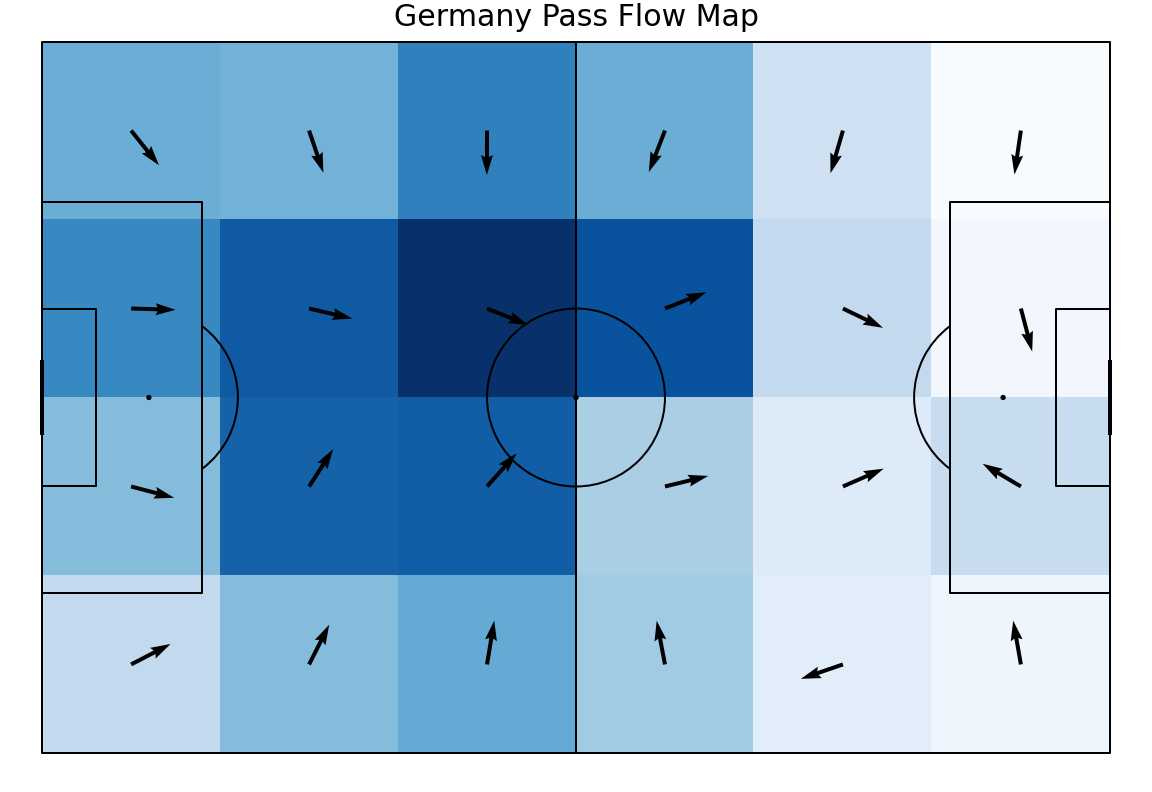
Goretzka or Kroos often looked to receive the ball behind the English attackers, attracting one of the English central midfielders and leaving the other one isolated and with a lot of space around him. Havertz and Müller knew this and dropped from the attacking line to both sides of the isolated central midfielder creating progressive passing lanes and space to receive the ball, turn and attack the defensive line directly.
One of the three English centre-backs often followed either Havertz or Müller but that generated space for Werner to attack and any quick combination between the lines resulted in a great chance to play a ball in behind and create a chance. Playing with a high line and against a player with Werner’s pace, it was very risky for the centre-backs to leave their position and press high.
Looking at Germany’s average positions in the match against England, we see how central Müller, Havertz and Werner were. They found the space they needed behind the English central midfielders and looked to exploit it. Hummels’ advanced position also shows how he was often given time to advance and play vertical passes.
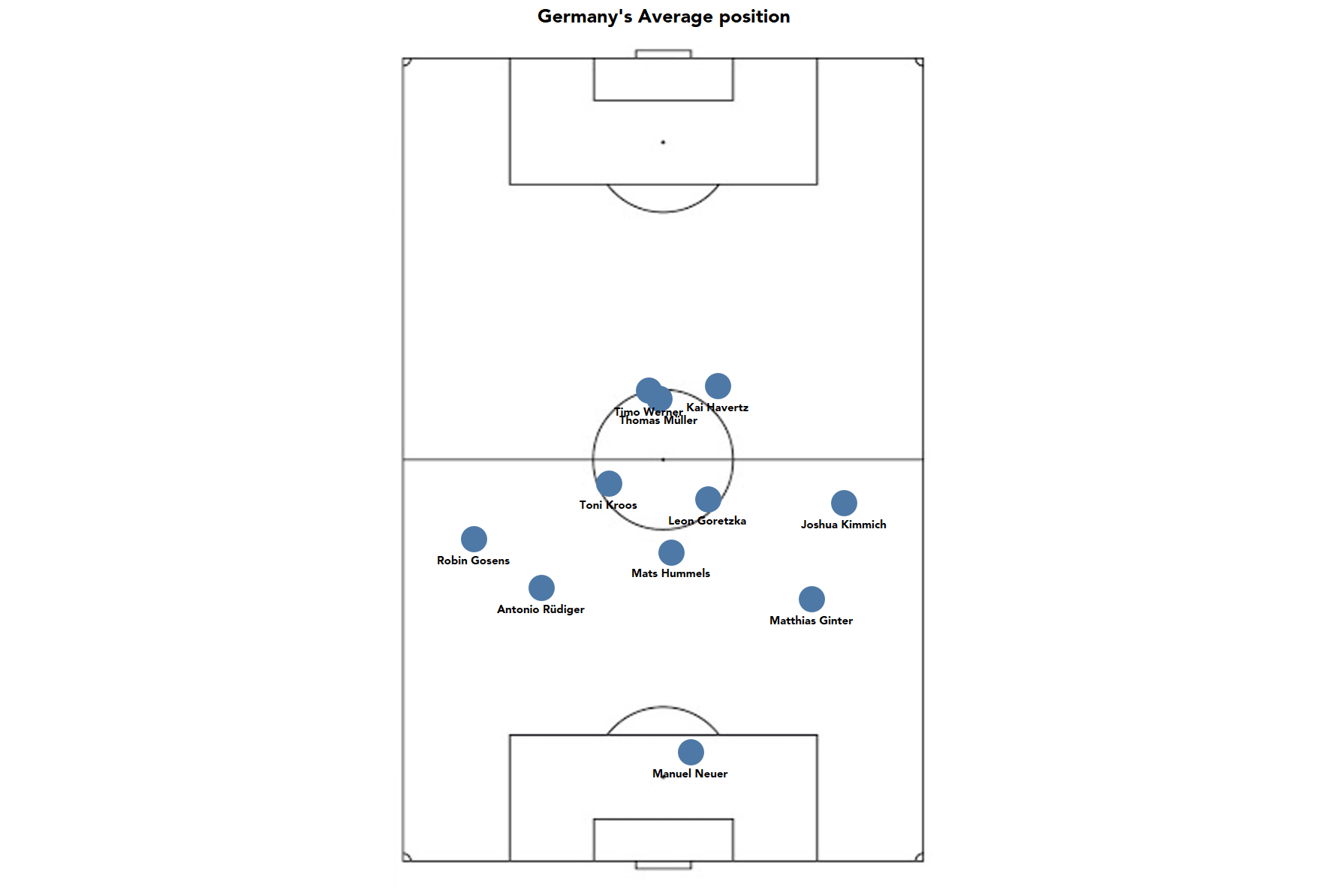
There were lots of examples of how easily Germany progressed through the centre so we’ll review some of them.
The first one below shows all the problems England have very clearly. Germany builds from the back against England’s front three who press but don’t engage in duels, giving Hummels time to play. Rice steps up and marks Goretzka, leaving Phillips alone in midfield.
Seeing the space around Phillips, Müller drops deep and receives a vertical pass from Hummels. Stones tries to follow Müller but the Bayern Munich player plays a first-touch layoff to Havertz, who has also dropped deep to the space left by Rice. When Stones leaves his position, Werner finds space to run and only Havertz’s bad touch prevents Germany from having a clear chance.
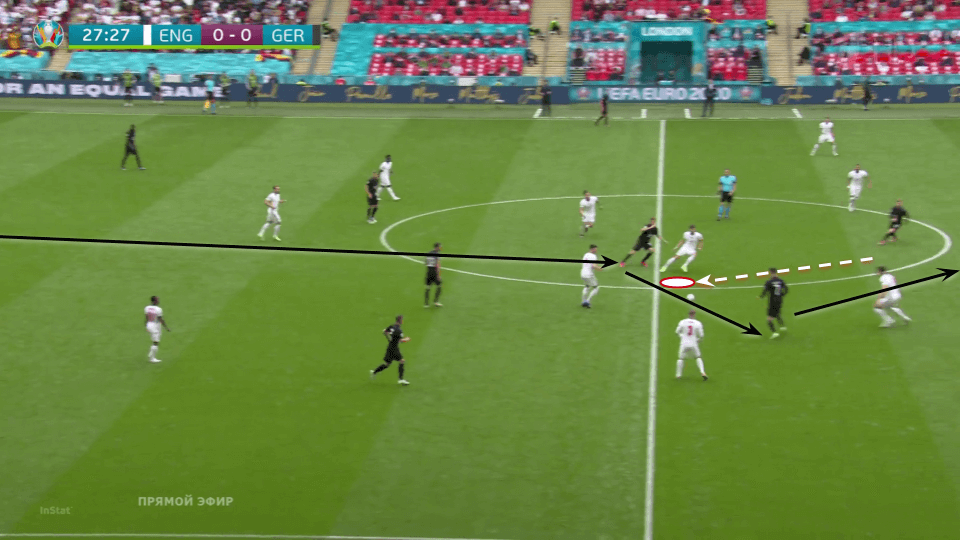
The sequence below is a similar one but the play is even simpler. Müller drops deep and receives a pass behind Rice and Phillips, who are quite far from the defensive line. Stones again leaves his position to mark Müller but he manages to turn and with a simple pass into the space the Man City defender has just left, he puts Goretzka in a one-on-one situation against Pickford. Only Rice’s recovery pace and his foul right before Goretzka got in the box prevented Germany from shooting from a very good position.
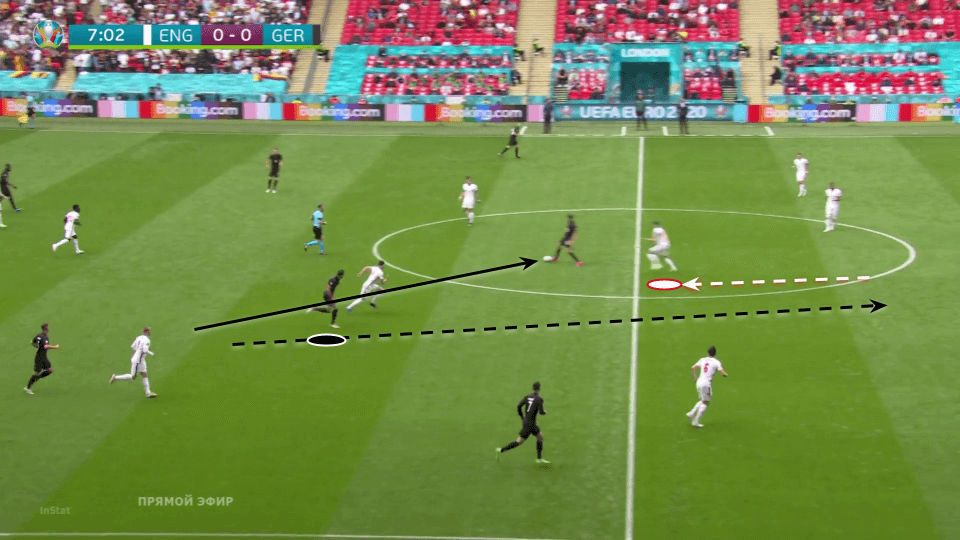
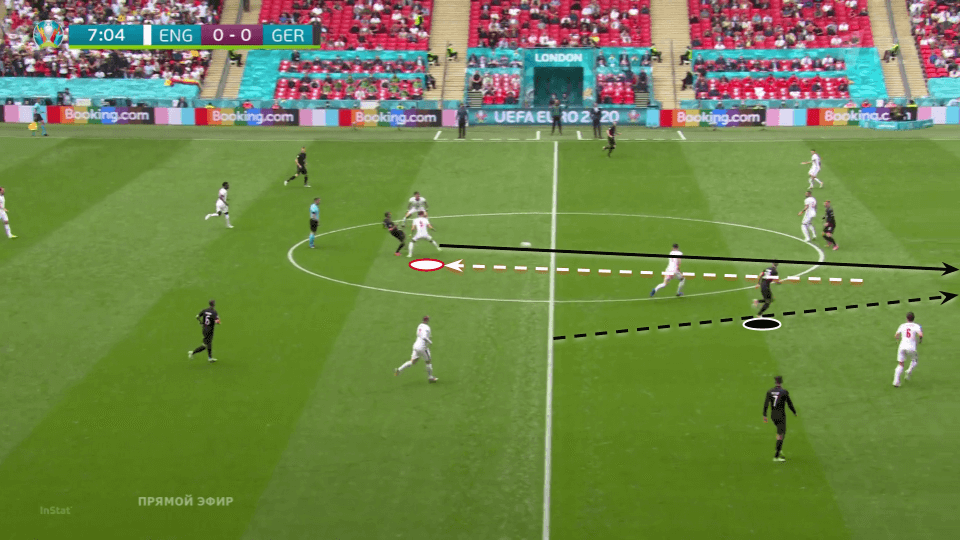
A similar logic applied for second balls when Germany chose to play more direct from the back. Both English central midfielders were too far from the defensive line and the German players were in a much better situation to win the second ball and attack the defensive line directly.
In the next picture, we see a long ball played from Neuer to Werner. The English centre-backs had the advantage in the air but even if they won the duels, any bad clearance would see them in a 3v3 situation at the back against the mobile and quality German forwards.
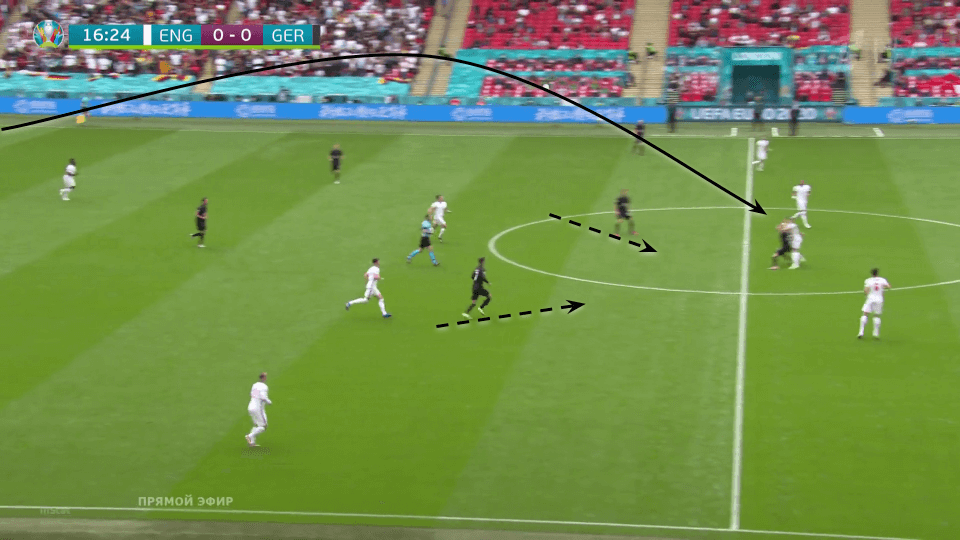
Germany understood this weakness and looked to exploit it very often. Once they had played through the first two pressing lines, they had plenty of options to create danger with Werner’s runs in behind and also with their wing-backs.
When they chose to play the ball wide, usually to the right, the three forwards were joined in the box by Goretzka and Gosens, overloading the box and providing plenty of options for an excellent crosser like Kimmich.
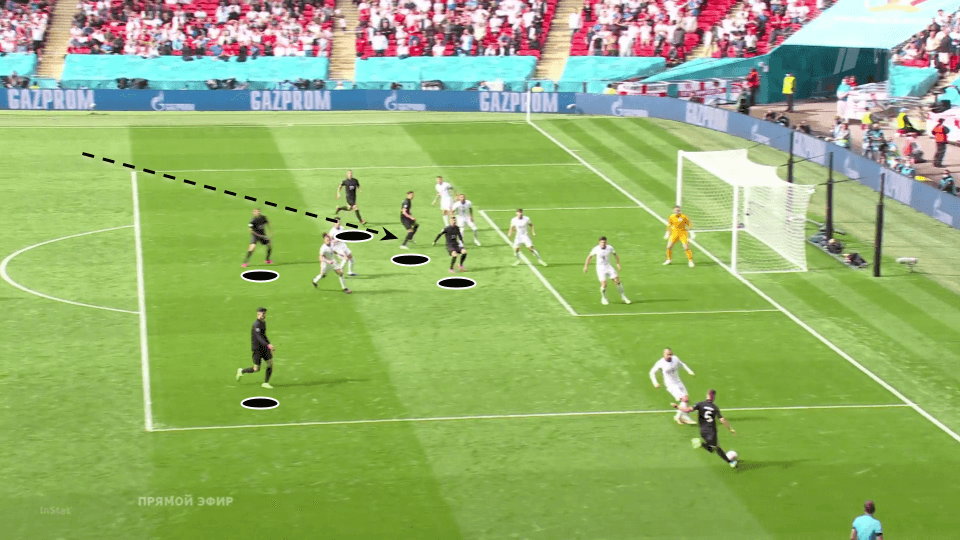
Plays like the one shown above were quite usual, with Kimmich crossing from the right and Gosens attacking the far post with powerful runs as we’ve seen lots of times in the Serie A this season. Below we see Germany’s crosses against England, most of them coming from the right side.
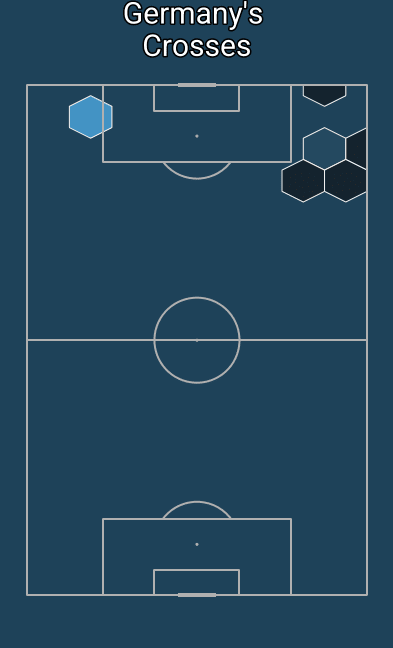
Despite this lack of compactness in the first half, Germany didn’t create too many chances. They weren’t accurate with the last pass and the English centre-backs were very good in duels, esècially Man United‘s Maguire, controlling the box and providing a solid base for the team.
In the next section of this analysis, we’ll focus on how England tried to build up and attack Germany.
England’s slow buildup against German solid block
Germany’s press was similar to England’s but with a much more compact shape that prevented England from finding spaces between the lines. They were a little more intense at some points but also sat back in a middle block a lot.
England’s buildup was slow and involved probably too many players. Germany didn’t leave any central spaces so the wide centre-backs were given space to play but struggled to break lines and just moved the ball from side to side most of the time.
There was also a lack of movement from English forwards and wide players. Both the wing-backs and the wingers often exchanged positions, occupying spaces between the lines or providing width to receive the ball at their feet to progress from midfield.
However, the feeling was that when the wing-backs had the ball wide they lacked the quality to find their teammates between the lines and when it was the wingers who dropped deep to progress, then they couldn’t find quality movement between the lines and relied too much on moments of individual brilliance. Both Sterling and Saka made some good individual plays and carried some threat but they couldn’t really combine with other players, especially with Kane almost disappeared.
The central midfielders did a good defensive job but they couldn’t find space to receive, turn and progress into the final third. Rice and Phillips combined only passed the ball 14 times to the front-three, which illustrates how flat England’s attacks were when playing through the centre.
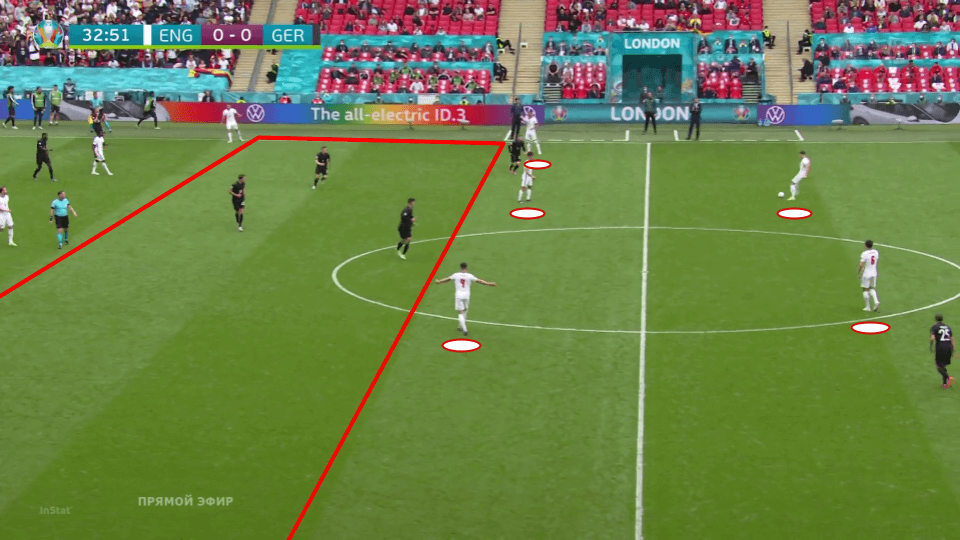
As an example, we can see the setup in the picture above. We see the English centre-backs and central midfielders deeper than the German forwards and the rest of the players very high up the pitch with no one offering passing options between the lines. This disconnection between the five players involved in the buildup and the wide and attacking players resulted in the ball going from side to side but without depth.
England’s slow buildup remained constant for most of the game but they managed to create chances from quick transitions and set-pieces. In the next section of the tactical analysis, we’ll see how they improved their defensive block and fluidity in the second half.
Southgate’s tweaks at halftime: a more compact England
While Germany didn’t change too much during the match, England made some tweaks at halftime to solve the problems we mentioned before in this analysis.
England’s front-three was narrower in the second half, preventing Hummels from progressing easily through the centre. The central midfielders also worked more as a unit, not leaving their positions to press high and forming a compact block with the forwards.
In the second half, England also sat deeper and forced Germany to play wide, knowing their main threat was between the lines. With the centre-backs and central midfielders controlling the box and its surroundings, Germany’s attempts from crosses and set pieces didn’t trouble England too much. England won 52% of the aerial duels and 62% of the defensive duels (48% and 53% for Germany), proving they felt comfortable in individual duels.
Another point Southgate improved in the second half was the role of the centre-backs when they left their positions. With the central midfielders covering the space in front of the back-three and England using a lower block, there was less space for the German forwards to drop into. One of the centre-backs still followed Havertz or Müller when they dropped deep but they didn’t go as far as in the first half and quickly communicated with Rice or Phillips so they took charge.
The image below is a good example of all this. We see the formation is the same but now the front three are very close to each other and leaving the flanks free for Germany to progress through there but not through the middle. Both central midfielders are now in the same line and forming a compact block so there isn’t space between the lines. We also see how Walker this time leaves his position but when MÜller drops too deep he communicates with Rice so he takes charge and returns to his position so there aren’t holes in the defensive line.
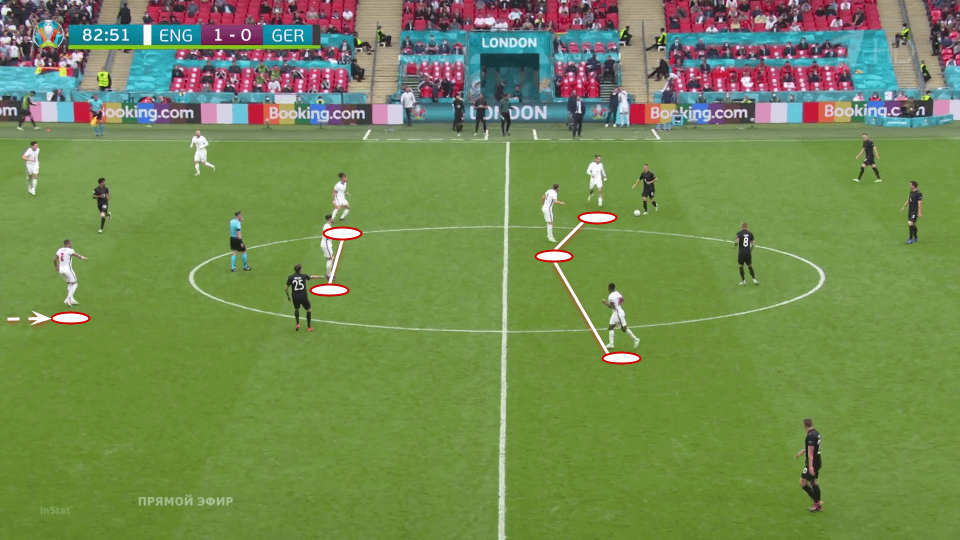
Without massive challenges, Southgate managed to solve the problems England showed in the first half. When Germany started getting frustrated and attacking more, Southgate introduced Grealish to take advantage of spaces but still maintained his pragmatic and conservative approach. As we’ll see in the next section of the analysis, chances in this match came mostly in transitions and it was England who had better tactics to take advantage of them.
Turning transitions and rival mistakes into chances
With both teams using a back-three and very solid blocks, positional attacks didn’t create a lot of chances. It was in transitions and quick attacks where both teams created their best chances. In fact, only 4% of England’s and 6% of Germany’s positional attacks ended with a shot, with those numbers increasing to 13% and 10% respectively for counterattacks.
Reviewing the chances both teams enjoyed from open play, we count two clear ones for each one. England converted both of them while Germany couldn’t. All of them came from transitions or vertical attacks. Let’s review them in order.
The first clear chance of the match came for Germany in the 31st minute and started from a Pickford’s goal kick. The English goalkeeper kicked it long but Germany won the header in midfield.
Introducing Grealish for the last 20 minutes was another good decision by Southgate. It’s true that not playing him from the start was a very conservative decision but it went well in the end. With England in a very open and wide position, Goretzka had time and space to pass it forward to Havertz, who received unopposed and drove the ball forward until he assisted Werner’s movement. The shot was stopped by Pickford.
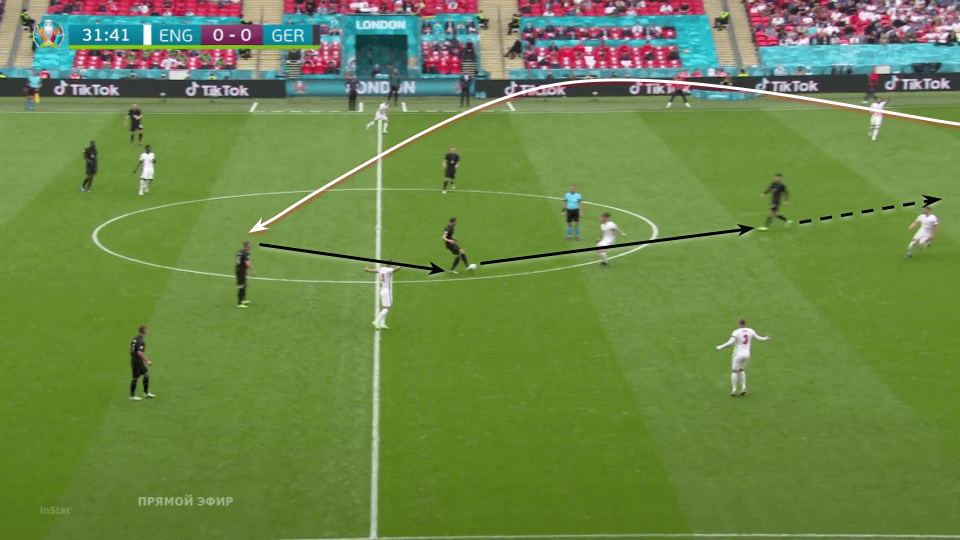
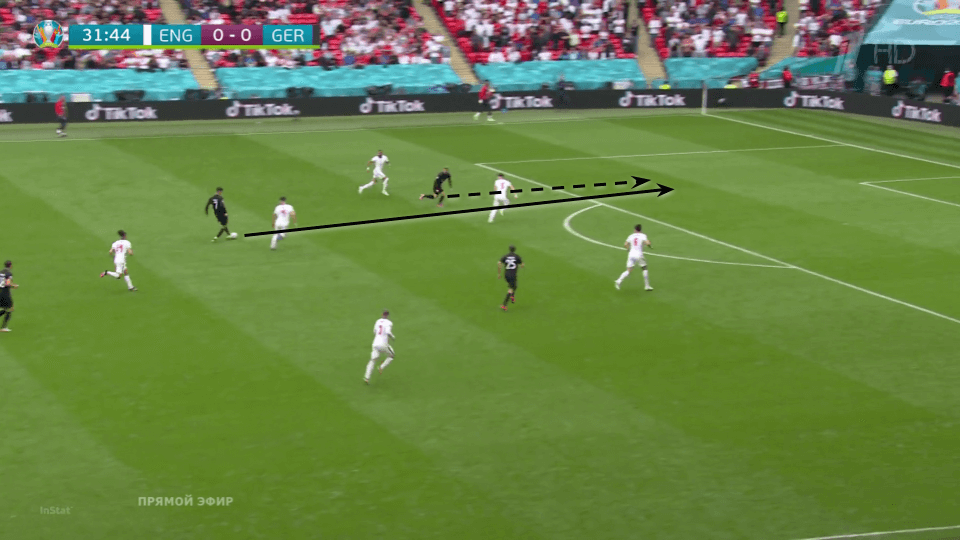
Three quick forward passes were enough for Germany to create a great chance, taking advantage of England’s poor positioning after losing the ball.
The second great chance was England’s first goal in the 75th minute. This time it wasn’t technically a transition but it was one of the few direct and quick attacks England had in the game. It started with England playing backwards on the left side. With Germany pushing their lines up with the backwards pass, England very quickly switched the game to the right side and played forward, finding Sterling around the final third as seen in the first picture of the sequence below.
Sterling turned and drove the ball through the German midfield line to pass it to Kane, who found Grealish at the edge of the box. The Aston Villa star attracted players and put a perfect ball to the left into the run of Shaw, who then crossed for Sterling to score.
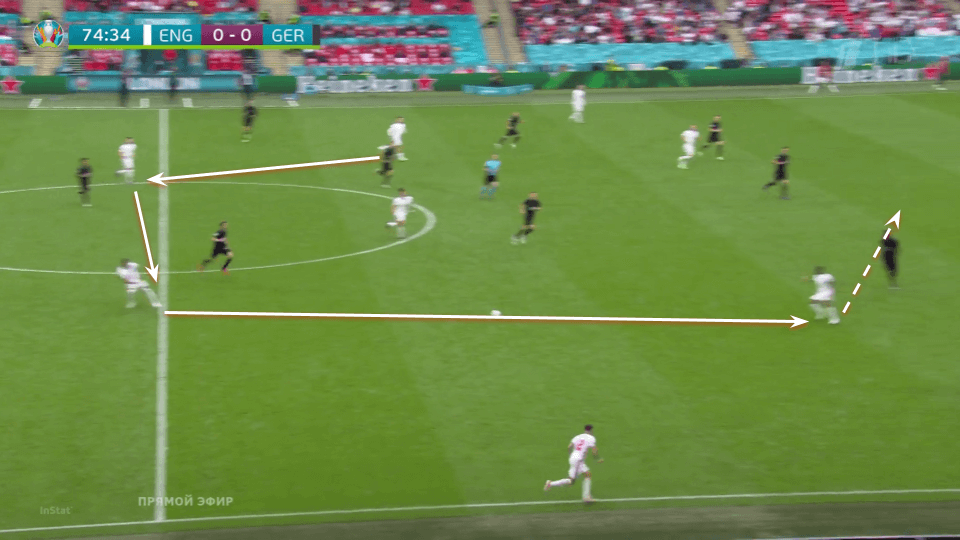
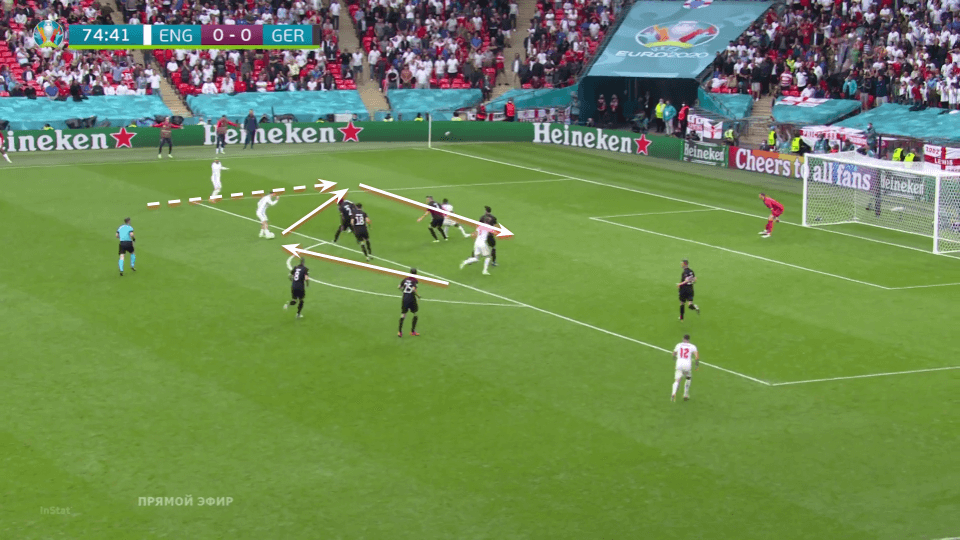
Just after that, in the 81st minute, Germany enjoyed their clearest chance, again in a transition after a mistake from Sterling. The Man City forward gave the ball away in a dangerous area and Havertz left Müller in a one-on-one situation with an easy pass. Müller shot from a very good position but his shot went wide.
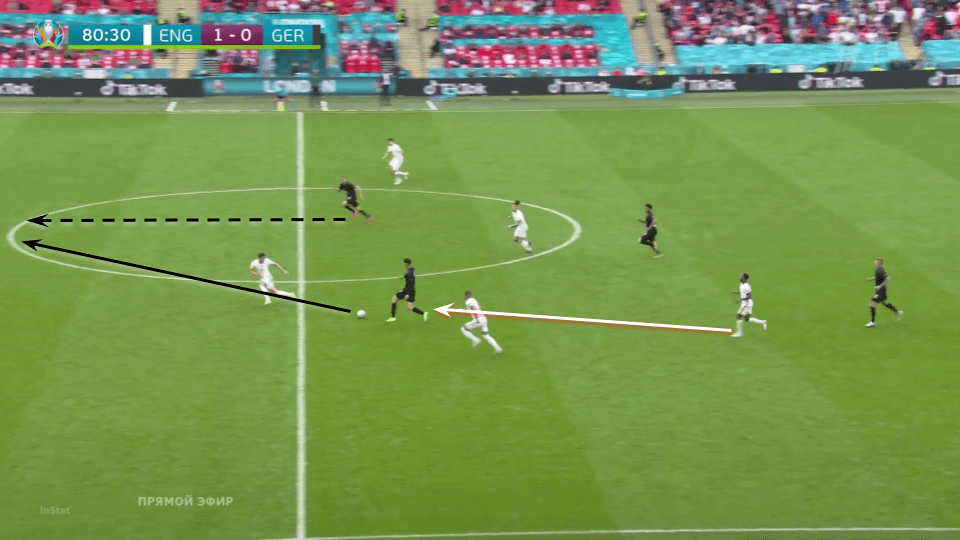
Again, a mistake was transformed into a quick attack to take advantage of England not having a good defensive shape.
Finally, England’s second goal in the 86th minute was also a transition after a mistake in the buildup. Gnabry received the ball from Hummels but Shaw was quick to press him and recover the ball, finding a lot of space in front of him to progress. With Germany defenders completely out of position, he gave the ball to Grealish on the left, who then crossed for Kane to score.
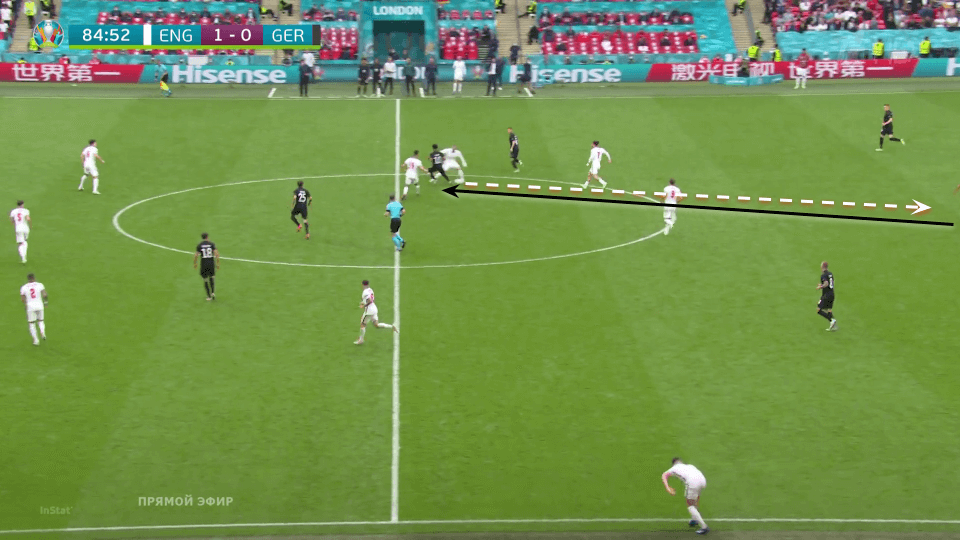
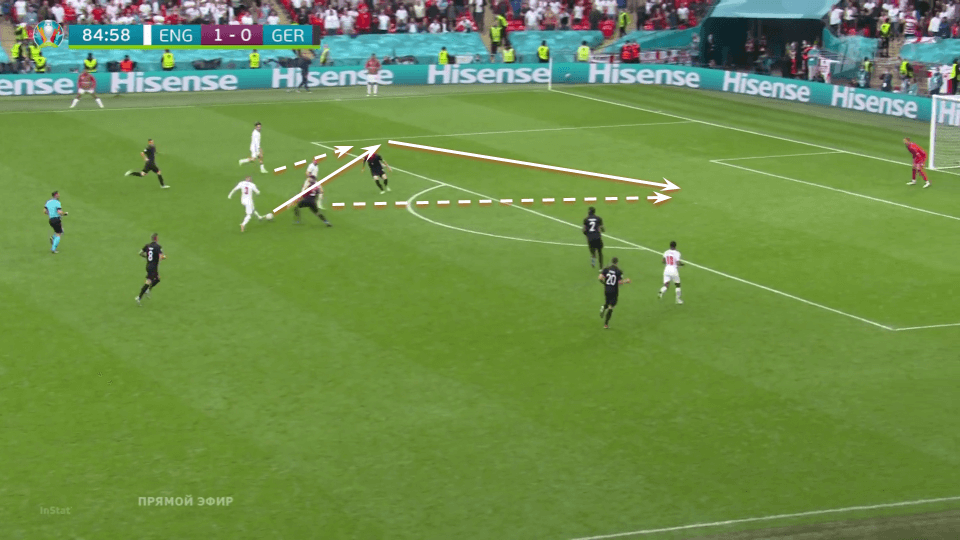
Grealish’s change didn’t change England’s tactics but was important in the goals with his ability on the ball and his intelligence to attract rivals and play the correct passes. He also freed space for Shaw on the left and forced Sterling into central positions as he didn’t feel as comfortable on the right and had to drift inside to have more options to dribble or shoot. His influence in both goals was great as we saw above.
In the end, and as it usually happens in games between teams with very solid structures like Germany and England, it was the mistakes and the few times they lost their shapes that decided the game. England also generated from set-pieces and deserved the win but it could have also gone the other way had Germany scored the great chances they had.
Conclusion
With a very solid display in defence and taking his chances, England managed to get past Germany and reach the quarter-finals of the EURO 2020. Southgate approach received some criticism, especially because of the amount of talent he left on the bench, but it turned out to be a good and pragmatic one, getting his team the victory against a great rival. This victory leaves an ‘it’s coming home’ feeling and now they’ll face Ukraine for a place between the best four teams in Europe in a clash in which West Ham stars Rice and Yarmolenko will face each other.
On the other side, Löw ended his spell at the German national team with a defeat. They had some moments of good football throughout the tournament but it’s clear that they need a fresh start. It will be nice to see how Hansi Flicks manages to get the best out of these players.


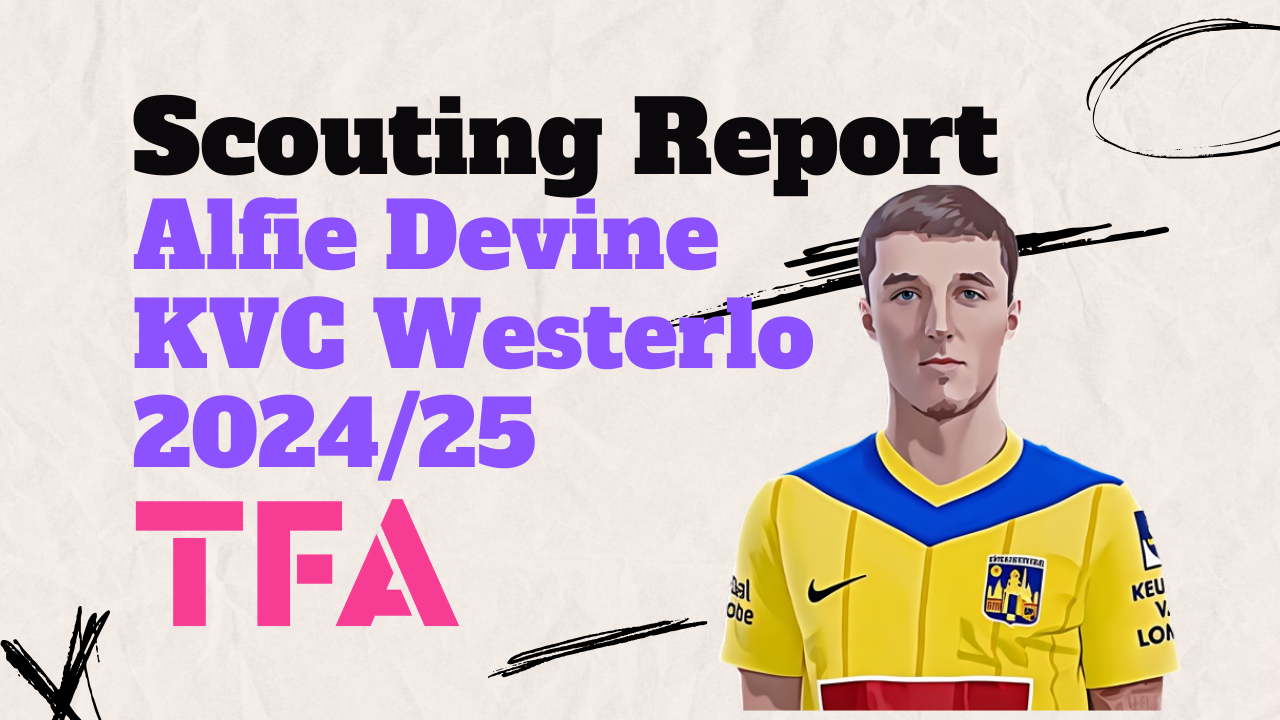

Comments